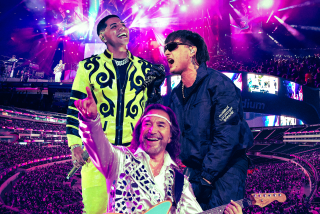Monterrey’s 3BALLMTY gives electronic dance some new rhythms
Detroit, Chicago and Manchester all had their moment as mad laboratories of electronic dance music.
Now it’s Monterrey’s turn. Mexico’s second-largest metropolis, a manufacturing hub, now specializes in the art of industrial noise. Texturally speaking, Monterrey’s prime contribution to EDM’s thumping ambience has been introducing the exuberant rhythms of northern Mexico and the Caribbean — specifically cumbia, vallenato and norteño, and accordion tracks — to the four-on-the-floor status quo.
No band currently is more emblematic of that renegade sound than 3BALLMTY (pronounced tribal or tree-ball Monterrey). The baby-faced collective consisting of Erick Rincón, DJ Otto and Sheeqo Beat won last year’s Latin Grammy as best new artist while saturating air waves and dance floors with its 2011 debut “Inténtalo.” The absurdly catchy title track off that album reached No. 1 on the Billboard Latin Songs chart last year. Already the song has become a cross-border go-to tune for getting people to move their behinds at Mexico City weddings and East L.A. quinceañeras.
PHOTOS: Celebrity portraits by The Times
Next month, 3BALL will bring its mixes to the Coachella Festival, hoping to show the lost children of the desert that its smooth-cheeked insouciance is more than a match for previous generations of EDM wizards.
“It was very emotional for us to be chosen for Coachella,” Rincón said, speaking in Spanish by phone from Monterrey. “It’s a festival that’s very on the top of the wave, and it’s something that’s very fundamental for any band, and in our case as a Mexican band, to be able play to a U.S. audience.”
If 3BALLMTY sports a refreshing sense of humility, it’s partly because the group knows its success is built on the work of its hometown predecessors. Among the most affluent, “Americanized” and bicultural of Mexican border cities, Monterrey (and the surrounding state of Nuevo León) has long been a crucial laboratory for Latin musical experimentation, producing its own indigenous rock, punk, hip-hop and electro-pop scenes before it turned to electronica.
“It started before us with bands like Control Machete, like Kinky, like Plastilina Mosh, and with the border very near,” Rincón said.
Of those groups, the most influential in 3BALL’s formation was Control Machete, the hip-hop ensemble whose mix-master guru, Toy Selectah, discovered 3BALL after stumbling upon its Myspace page and contacting it. Toy then invited the band to his Monterrey studio and offered to produce its debut disc.
Speaking by phone, Toy said he’d first tuned into the “tribal” (i.e. “tree-ball”) genre in 2007 while scouring Mexico City flea markets. He believes that the genre’s appropriation by 3BALL and its Monterrey brethren has brought not only a tropical flow to the music but a working-class attitude and machine-driven energy similar to what fired up the music in blue-collar burgs like Detroit and Manchester.
“Generations of workers, they were there making steel, making cars, making glass, making beer,” Toy said. “And that’s exactly what happened in Monterrey.”
PHOTOS: Iconic rock guitars and their owners
The 3BALL creation myth has a suitably techno twist. Its members met via the Internet and decided to form a collective, not merely as DJs but as musicians and producers.
“We talked about how it would be very cool to play and get involved on both sides of production,” said Rincón, who cites Italian DJ-producer Marco “Benny” Benassi, the Dutch-Surinamese DJ Chuckie and Detroit DJ-producer Jeff Miles among his long-distance mentors. “We saw guys like Tiesto and Deadmau5 who were DJs, and they taught us how to convert ourselves into someone like them.”
One advantage the band had, he added, was that in Mexico and most of Latin America “there are no electronic music idols.” Consequently, the Spanish-language EDM scene has been relatively free to set its own terms and define its own space, and there’s still plenty of room for newcomers.
“I think the Mexican electronic music, and Latin electronica in general, it’s not house, it’s not something that existed before,” Rincón said. “It’s a new proposal for electronic music.”
When 3BALL hits Coachella, Toy said, it will drive home the point that Mexican and Latin American techno collectives not only are worthy of attention but also that they are part of the bigger global EDM conversation, not mere sonic curiosities.
“It’s a chance to show the world what’s going on with three 20-year-old kids south of the border,” Toy said, “making chaotic dance music for the 21st century.”
PHOTOS AND MORE
COACHELLA: Complete 2013 lineup
THE ENVELOPE: Awards Insider
PHOTOS: Grammy top winners
More to Read
The biggest entertainment stories
Get our big stories about Hollywood, film, television, music, arts, culture and more right in your inbox as soon as they publish.
You may occasionally receive promotional content from the Los Angeles Times.











